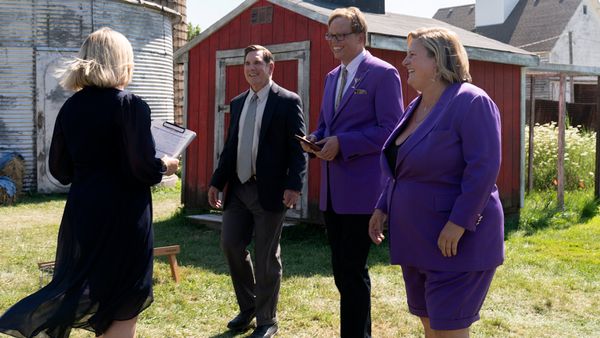
October 22, 2017
Mythical Creatures Unbound
Sura Wood READ TIME: 4 MIN.
Long before Walt Disney dreamt up the Magic Kingdom, dancing brooms and evil queens proffering poison apples, wizened Jewish storytellers were unraveling the mysteries of the universe, human nature and the supernatural. With whimsy, no small amount of invention, fantasy, humor, and, where indicated, a little bit of schlock or pointed social commentary, 16 primarily local artists have now put their own modern stamp on traditional Jewish stories and characters in "Jewish Folktales Retold: Artist as Maggid." A respite from the seriousness of the fall exhibition season, the show, on view at the Contemporary Jewish Museum, is an unmitigated delight. Relying on a combination of old-world cautionary tales and Howard Schwartz's 2009 anthology "Leaves from the Garden of Eden: One Hundred Classic Jewish Tales," the artists chose source material they gravitated toward, producing primarily non-linear interpretive works. The loopier those interpretations, the greater the fun. Clearly, the creators had a grand time, and their pleasure is infectious.
As soon as visitors enter the gallery, they're lured into the fantastic, as if by a carnival barker crooking a finger toward his tent, by Mike Rothfeld's deliberately low-fi, portentously titled sculpture, "It is tomorrow we bury here today." A fabulous vision of an alternate future, it revels in its own cheesiness, and that's meant as a compliment. Walk underneath the theatrically lit, iridescent, electric-blue archway, and all you have to do is close your eyes, click your heels together, and poof, you're transported to the inside of a purplish cave in a locale as close or as far as your imagination will take you. In truth, you'll be face-to-face with the detached rear portion of the cave, adorned with green-and-gold ornaments and rivulets of an unidentified substance suggesting melting stalactites. Made out of what looks like dinner-theater papier-m�ch� - actually painted polyurethane foam - it's a triumph of fakery familiar to anyone glued to mid-20th-century Saturday-morning TV serials, or episodes of Flash Gordon and Star Trek in its leaner days.
Sacramento artist Elisabeth Higgins O'Connor is a builder of a different stripe. Her improvisatory process, which begins with a series of preparatory collages, results in large-scale creatures or monsters one might find hiding under the bed if they could fit, or poised to jump out a closet in a child's nightmare. For this project, O'Connor turned to the Golem, a powerful mystical, half-dead, half-living entity forged from mud and stone that, legend has it, was sent to protect the Jews from persecution. Armed with wire, strips of paper, string and other detritus, she deployed gorilla glue, painted Styrofoam, discarded wood, cardboard, lace curtains and bed linens to construct two jumbo-sized, mythical characters engaged in a version of call-and-response. One of them is a vogue-ing, bubble-gum-pink bull on bended knee ("lullaby/lament"). Arms extended, a hoof supported by a box, confetti streaming from its chin, it strikes a pose, having slid into the crowd-pleasing finish of a showboating performance, perhaps to impress a pointy-snouted wolf or coyote a few feet away ("Blame/thirst").
Meanwhile, M. Louise Stanley displays a piquant wit in "Casting Call for Cautionary Tales" (2017), a painting that envisions stock fairy-tale characters - princes, princesses, giant avians - auditioning for roles in a play, such as the towering oversized goose intently reviewing a script with a peasant director in a barn that doubles as a theater. In "She Waits," the artist riffs on "The Finger," a story she uncovered about an unusually optimistic buried bride attempting to seduce a potential suitor by flagging him down with a single digit pointed skyward from her grave. A note on the canvas intones: "She waits patiently for discovery only to be entombed once again, but deeper." Such was the fate of women in olden times. And for children (or souls) lost in the woods, there's Andy Diaz Hope and Laurel Roth Hope's "The Woulds," a petrified enchanted forest with bare, stunted trees and hanging crystals that cannot found on a map of the known world.
Influenced by pop culture, movies and camp, the arsenal of Berlin/Oakland-based provocateur Tracey Snelling can come with a scathing feminist subtext and seedy patina. Here, she upends a patriarchal vision of gender roles and female sexuality in "Lilith's Cave," a tale of a teenage girl possessed by demons either before or after being rejected by her father because of her promiscuity. Snelling reclaims girl power in a multi-part installation that includes a diorama of a feminine bedroom with a miniature mirror playing a loop of film clips featuring defiant female protagonists - I'm pretty sure I saw "Lara Croft" and "Carrie" float by - and a vamping teen queen. On a nearby wall, "She-Evil" is spelled out in blinking pink neon, and a faux movie poster, encased in a lightbox, touts "Lilith's Night Out" with the tagline: "They tried to tame her, but she had her revenge." You go, girl!
Through Jan. 28; thecjm.org







